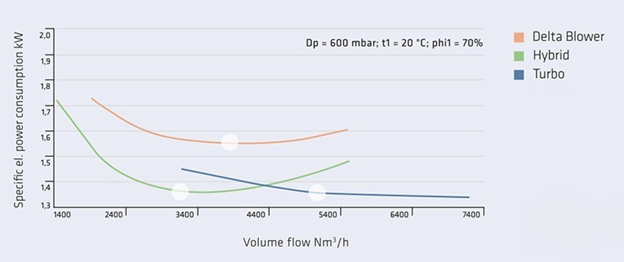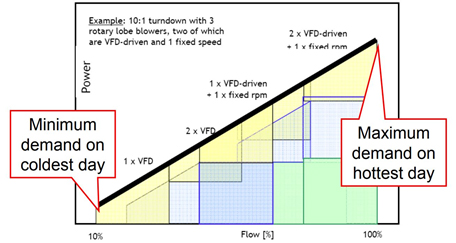In regulated wastewater treatment plant (WWTP) environments, which require 100 percent blower system redundancy to satisfy the most extreme operating conditions, it can be easier to meet demanding physical thresholds than it is to refine energy performance to the ideal minimum. Here are some guidelines for covering all the bases — estimating the potential payback of balancing blower type, size, and turndown capacity while making the evaluation exercise worth the effort
Qualifying The Problem
Inefficient blower sizing at either extreme can compromise
cost-effectiveness. Oversized units result in wasteful energy
consumption due to the generation of underutilized aeration capacity.
Undersized units push operating limits so close to the extreme as to
incur excessive maintenance costs or risk running equipment into the
ground.
The most typical case of inappropriate sizing is using an oversized
blower that wastes energy for at least some portion of the daily plant
cycle. Given that 60 percent to 80 percent of energy consumption in
WWTPs is devoted to biological treatment, it is not hard to appreciate
how expensive waste can become. Ask these key questions about blower
system redesign to identify potentially major impacts on energy costs:
- Is the original aeration system design now outdated compared to current operating demands? Was
the blower installation originally designed for an anticipated growth
spurt that never occurred? Or are the blower configurations unable to
scale back efficiently during low-demand periods such as winter nights?
Whether a blower installation was
appropriately sized for the initial installation or not, operating
conditions might have changed since then, requiring a new evaluation.
Blowers typically operate most efficiently at around +75 percent of their rated maximum operating speed, comparable to the efficiency of an automobile at cruising speed.
Is the existing aeration output excessive for a significant portion of daily demand? Because
blower systems are often generously oversized to accommodate regulatory
approval for “worst case” operating conditions, many operate at only 50
percent to 66 percent of rated capacity much of the time. If the blower
type lacks sufficient turndown capacity, that can lead to tremendous
inefficiencies during periods when biochemical oxygen demand (BOD) is
significantly less than the lowest practical output of the blower
(Figure 1)
 Figure 1. Each blower technology has a “sweet spot” of cost-effective energy efficiency that needs to be factored against capital cost and the relative proportion of the BOD load it will carry from day to day.
Figure 1. Each blower technology has a “sweet spot” of cost-effective energy efficiency that needs to be factored against capital cost and the relative proportion of the BOD load it will carry from day to day.
Does a blower run hot under high-demand conditions, or is it incurring a noticeable increase in repair incidents due to excessive run time near or higher than the maximum rated running pressure?
Taking A Quick Measure Of The Situation
Don’t let arithmaphobia or math anxiety get in the way of evaluating blower efficiency. The only way to quantify the best options for ensuring maximum blower capacity and energy-efficient flexibility is to work through the numbers. That means not just the number and capacities of blowers in the bank, but also the types of blower designs needed to adapt to the most common demand fluctuations. Work with a knowledgeable blower professional experienced in navigating the ins and outs of WWTP applications or use in-house data resources to chart a snapshot of current conditions and practices.
The most accurate way to quantify operating cost is to have blowers independently metered for energy consumption separate from other plant operations. Since that is not a common practice in the water space, it is more typically necessary to calculate estimated energy costs from historically known BOD volumes and the relative efficiencies of currently installed equipment. Collect or calculate the following values:
Cost Per kWh By Time Of Day. Since many utilities differentiate costs based on peak and off-peak hours, matching those variable costs per kWh against the volume of aeration demand at those times of day can provide a good sense of current costs. If that information is not readily available, it will be necessary to work from an average monthly bill and historical plant throughput at various times of the day.
Demand Curve. Charting the historical demand curve for aeration — by time of day and/or time of year — will provide a good indication of aeration requirements over the course of a year. The goal is to match the required load profile as closely as practical without generating more flow than necessary. Using fewer bigger units creates big step changes and a large volume of waste when a second unit comes on-line due to demand exceeding the capacity of a single unit by a mere fraction.
Seasonal Factors. Knowing that oxygen demand is affected by atmospheric conditions, it is valuable to compare actual demand vs. rated blower capacity. A classic extreme is a summer resort town in a northern climate where demand can vary tenfold in-season during a 90-degree summer, as compared to what it is on a cold winter night during the off-season.
Turndown Capacity. Different blower designs offer varying degrees of turndown — i.e., the capability to run efficiently at less than full volume. For example, turbo blowers will allow only about 2:1 turndown, based on the limitations of the impeller design. By contrast, a hybrid low-pressure screw compressor can offer efficiency comparable to a turbo compressor, but with greater turndown capacity of 4:1.
Matching The Right Resources To The Application
The key to rightsizing is to cover all the bases — worst-case demand and most-efficient running performance — with the greatest flexibility in bringing different units on-line and off-line. Armed with a good sense of oxygen demand and relative energy costs for peak and off-peak periods, map out a matrix of various blower type and size combinations to match the demand as efficiently as possible (Figure 1).
Use turbo blowers for base load. High-speed turbo blowers are extremely efficient for continuous high-volume demand applications. Their capital costs can be offset by running them at their most efficient operating range — typically between 60 and 80 percent of maximum capacity. Because their effective turndown capacity is limited to only about half of peak volume, however, they do not adjust economically to significantly lower off-peak demands.
Add hybrid blowers for control. Hybrid rotary-lobed screw displacement blowers that use a low-pressure screw compressor can provide economical high-volume performance without turndown drawbacks. By providing economical turndown performance — as low as 25 percent of maximum throughput — they can deliver efficient performance over a wider range of demand for 15 percent less energy cost than a conventional displacement blower.
Consider displacement blowers for standby. Conventional displacement blowers offer robust endurance and can deliver energy efficiency and low lifecycle costs in the low- to medium-flow volumes. As such, they are an affordable standby option for periodic use when fluctuating demand exceeds the capacity of turbo and hybrid units in an existing bank of blowers.
Factor in turndown capability. Aside from the inherent maximum performance characteristics of each blower type, it is important to consider how efficiently each type of blower will operate during periods of lower demand. This helps guide decisions for efficiently meeting maximum and minimum demands across normal seasonal and daily fluctuations.
Finding Balance In A Blend
No single blower type is capable of equally cost-effective response across all changing airflow demands (Figure 2). When banked in appropriate combinations to feed a common header, however, the right mix of blower types and capacities will deliver reduced investment cost, maximum energy efficiency, and highest energy savings. The capability to strike the right balance among all demand levels can deliver savings on the order of 17 percent to 28 percent over any single blower technology
 Figure 2. Combining fixed-speed and variable-speed
blowers makes it practical to respond to a wide range of air demand
efficiently while providing necessary redundancy..
Figure 2. Combining fixed-speed and variable-speed
blowers makes it practical to respond to a wide range of air demand
efficiently while providing necessary redundancy..